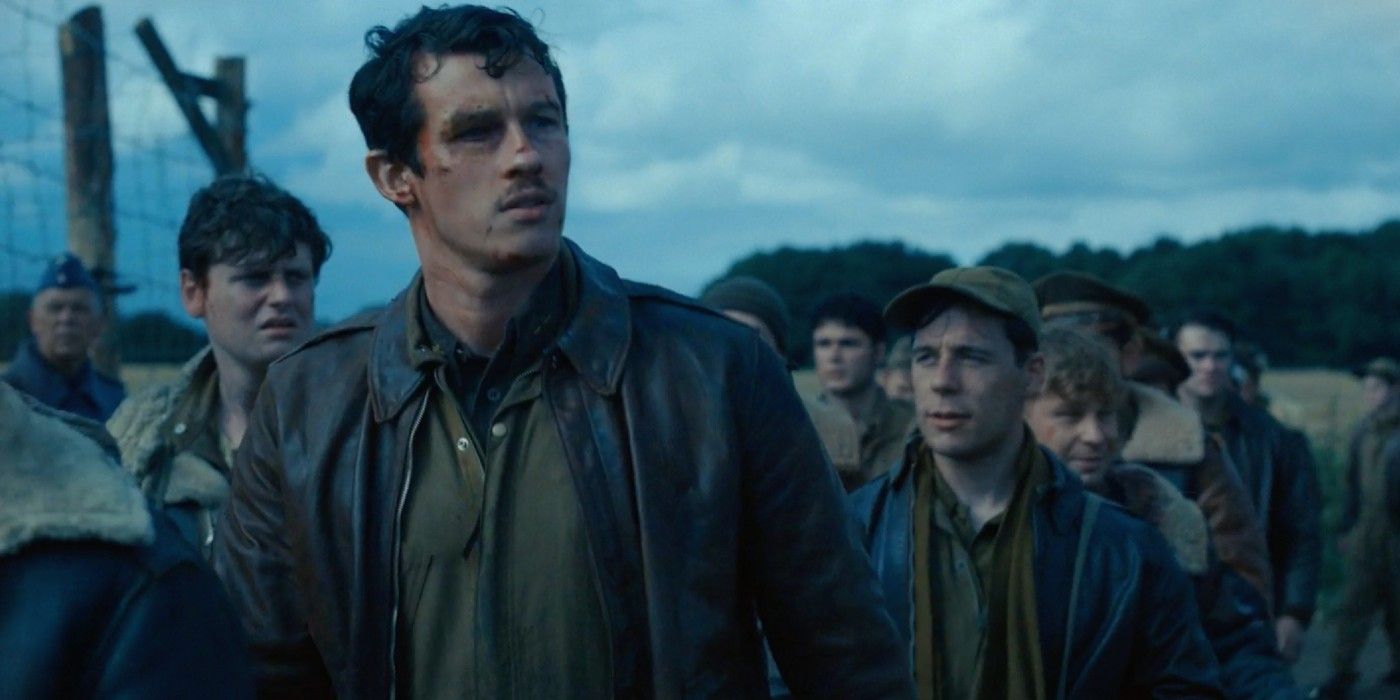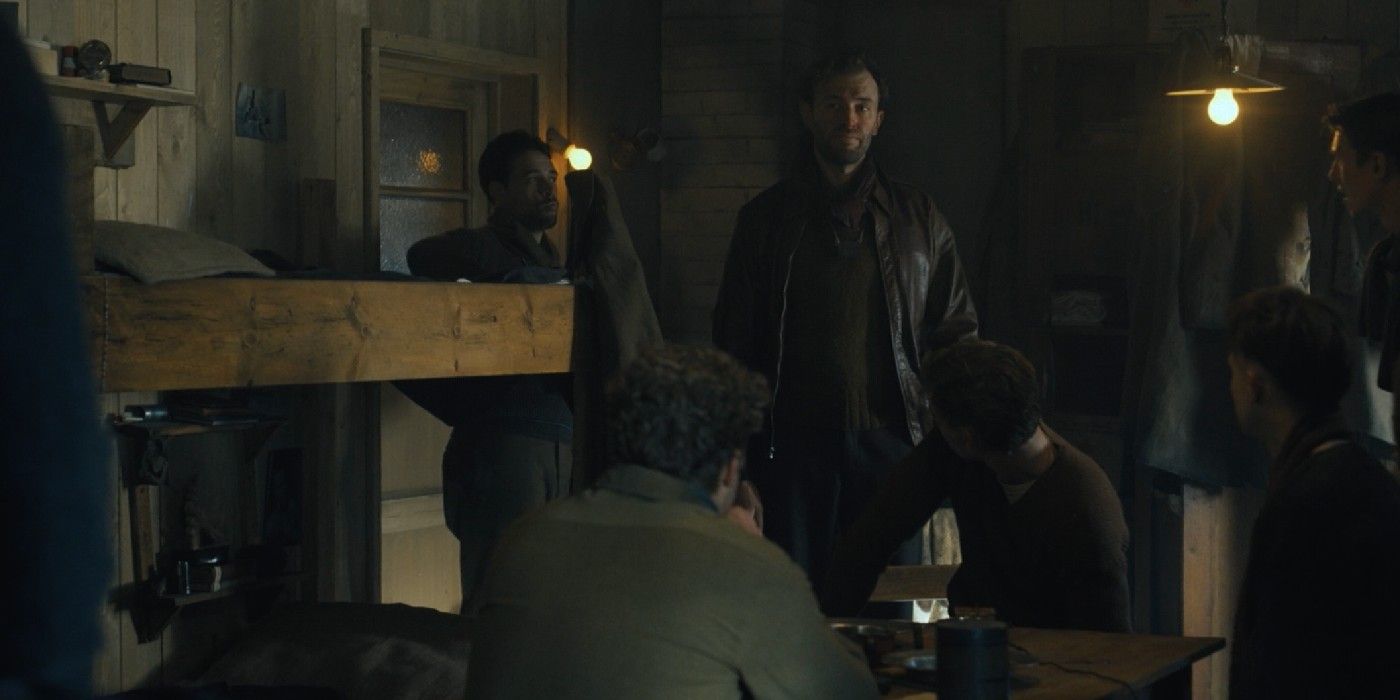
Unveiling the Legendary Escape from Stalag Luft III in Masters Of The Air Episode 7

Delve into the epic tale of Stalag Luft III's historic Great Escape as depicted in Masters Of The Air Episode 7. Learn about the daring breakout that captivated audiences worldwide.
The seventh episode of Masters of the Air contains spoilers.
The series has taken a different approach in the second half by focusing on life in a POW camp. This shift in narrative allows the show to explore significant events from real history, such as The Great Escape from Stalag Luft III. Episode 7 of Masters of the Air highlights this famous event, which was an ambitious but ultimately unsuccessful attempt to break free from the POW camp, leading to consequences for both the prisoners and the escapees.
In episode 7 of Masters of the Air, titled "The Great Escape," we see Gale 'Buck' Cleven, John 'Bucky' Egan, and other POWs from the 100th Bomb Group taking matters into their own hands at Stalag Luft III. They decide to build a radio in secret to stay informed about the war. However, their plan hits a roadblock when they find out that British POWs have escaped through tunnels, putting everyone at risk as the German officers become more vigilant.
Callum Turner as Major John Egan entering Stalag Luft III in Masters of the Air - How The Prisoners Escaped From Stalag Luft III Explained
The Great Escape was a project that took a year to complete and was mainly carried out by British soldiers held at Stalag Luft III. The idea was thought up by Royal Air Force squadron leader Roger Bushell. The key to The Great Escape was the tunnels. Between March 1943 and March 1944, over 600 prisoners of war collaborated to secretly dig tunnels to escape from Stalag Luft III. Despite the camp's sandy ground that made tunneling challenging, the men succeeded in constructing three tunnels known as Tom, Dick, and Harry.
The tunnels at Stalag Luft III were not basic. Each tunnel had an air pump, staging posts, and workshops for storing supplies. They started in discreet spots inside certain huts. The plan was to build three tunnels so that if one was discovered, the Germans would not suspect the other two. This strategy paid off when one tunnel, named Tom, was destroyed. Originally planned for summer, The Great Escape was moved to March due to increased security measures by the Gestapo.
On March 24, 1944, prisoners at Stalag Luft III used the tunnel named Harry to attempt their escape. The frozen entrance caused a delay, and the tunnel's exit did not reach beyond the tree line, making it risky near a guard tower. Despite these challenges, the men made their way through the tunnel and escaped in the early morning hours. The operation came to an end when one escapee was spotted from the guard tower and had to surrender.
How Many Prisoners Escaped From Stalag Luft III
Callum Turner as Major John 'Bucky' Egan from masters of the air holding a gun in the tall grass hiding from a hunter - How Many Prisoners Escaped From Stalag Luft III
In the end, only 76 men managed to escape from Stalag Luft III through the Harry tunnel. They either walked to a nearby train station or roamed the countryside. This was a much smaller number than Bushell's original goal of rescuing 200 men from the POW camp. The meticulous planning of The Great Escape was primarily due to this target number. However, it also posed challenges as only 200 out of the 600 men involved in tunnel construction could actually flee.
The escapees were carefully chosen based on their abilities. The 600 men were divided into two groups. The first group, known as "serial offenders," consisted of individuals with the best chances of successfully escaping. They possessed authentic documents, civilian attire, and proficiency in German. This group also included those who had dedicated the most effort to tunnel construction. The second group, referred to as "hard-arsers," lacked proper documents or German language skills. They were selected through a random draw and had to travel discreetly at night to avoid detection.
Though the men involved in The Great Escape came from different countries, only one American, Major Johnnie Dodge, was part of the plan and he had become a British citizen.
Were 50 Of The Escapees Really Caught & Killed?
Austin Butler and Callum Turner as Buck Cleven and Bucky Egan Masters of the Air 7 - Were 50 Of The Escapees Really Caught & Killed?
In Masters of the Air, the excitement of The Great Escape turns into tragedy when a German officer discloses that 50 of the escapees were tragically killed. This heartbreaking event actually occurred in real life. Following the discovery of The Great Escape, the officers at Stalag Luft III conducted an investigation to determine the number of prisoners who had successfully escaped and the extent of the elaborate plan.
Ultimately, they managed to capture 73 out of the total 76 escapees.
Adolf Hitler was furious and wanted to execute all of them, but he was advised against it because there were German prisoners of war in Allied camps and there could be serious consequences.
The Great Escape had a significant impact on Stalag Luft III.
In the end, Hitler ordered the execution of more than half of the escapees, totaling 50 out of 76 men. Among those killed was the leader of The Great Escape, Roger Bushell. The victims came from various nationalities such as British, Canadian, Polish, Australian, Argentinian, South African, French, and more. Following the massacre, 17 of the remaining escapees were returned to Stalag Luft III, while others were transferred to different POW camps or concentration camps. Fortunately, the three successful escapees found refuge in neutral or Allied countries, escaping the fate that befell their comrades.
The 100th at Stalag Luft III Masters of the Air episode 7 - How The Great Escape Changed Stalag Luft III
The Great Escape at Stalag Luft III was a remarkable event, but unfortunately, it had dire consequences. Most of the escapees were captured and killed, leading to stricter conditions at the camp. The officers had to enforce rules more harshly to prevent further escapes. In the world of Masters of the Air, Buck and Bucky's radio poses a serious risk that could result in their death.
During the months between The Great Escape and the fall of Stalag Luft III, it was a challenging time for the soldiers. The camp provided some amenities, but things got tougher after The Great Escape. To survive, the POWs had to lay low. Fortunately, the camp was eventually closed down within a year, allowing many of the remaining men to go back to safety. Masters of the Air is expected to delve into the impact of The Great Escape and its lasting legacy.
Editor's P/S:
The article "The Great Escape: Masters of the Air Highlights Historic POW Camp Escape" delves into the fascinating yet tragic events of The Great Escape from Stalag Luft III during World War II. The episode exposes the daring attempt by Allied prisoners of war to break free from a German prison camp through a series of tunnels and the devastating consequences that followed. The meticulous planning, immense dedication, and desperate courage of the escapees are both admirable and heartbreaking.
The article also sheds light on the grim fate of 50 of the escapees, who were captured and executed by the Nazis. The senseless loss of so many lives serves as a reminder of the atrocities committed during the war. The article's detailed account of the escape and its aftermath provides a sobering glimpse into the harsh realities of life as a prisoner of war and the horrors of conflict.

















